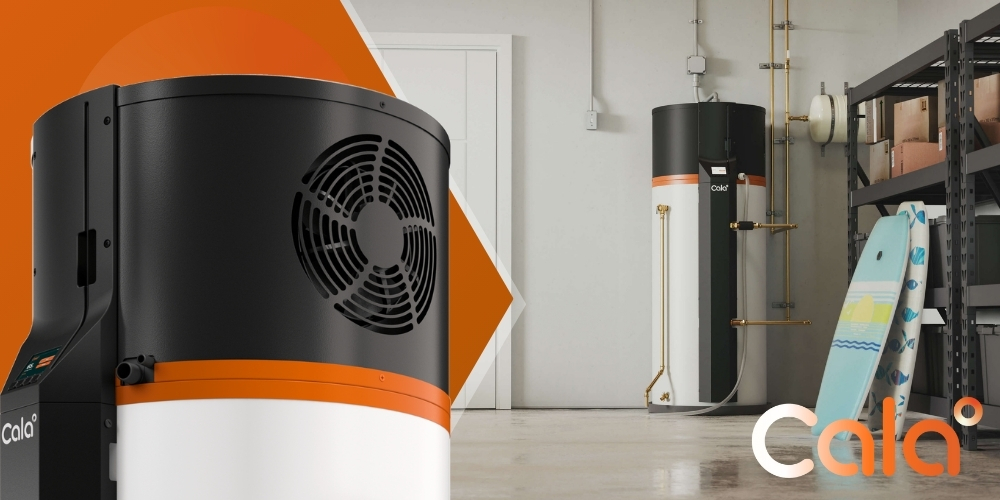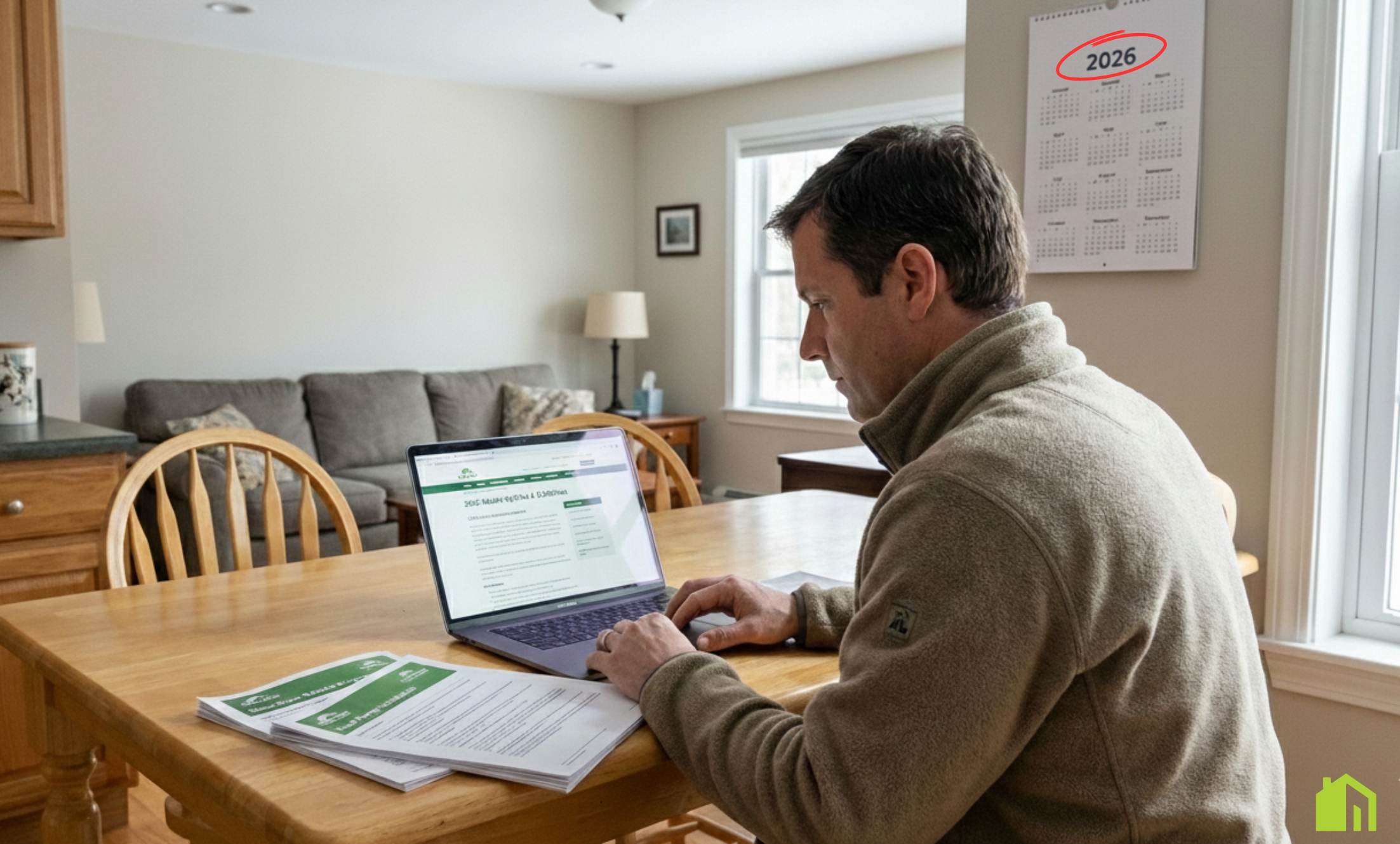Make-Up Air Systems: Solving Pressure and Ventilation Imbalances

Intelligent Heat Pump Water Heaters for Massachusetts Residential Homes — Why SumZero Selects Cala
By SumZero Energy Systems — Massachusetts’ #1 Heat Pump Installation Team
Picking a new water heater once involved a simple decision between gas and standard old electric, praying the hot water wouldn't be gone when there were two showers in a row. That's no longer the case. Now, the ideal solution for the majority of Massachusetts homes is a smart heat pump water heater (HPWH). This isn't the typical hybrid of which you might have heard, but a rather new breed of unit that adapts to your home's schedule, accommodates your energy usage, and maintains comfort consistently while consuming a lot less energy.
When homeowners want to have it exactly right the first time, our team is discerning about what products we choose. We consider the landscape and inspect the details before determining that they might work with Cala, a company that produces a high-technology hot water heater that modern homes need: intelligent, consistent, and efficient hot water — installed properly. This article describes why this alliance matters, how the tech benefits your home, what you should expect from our installation, and the handy information (rebates, credits, fit questions) homeowners inquire about daily.
Why This Alliance Is Important
(and What It Does for You)
There are two parts to a successful hot water solution:
Great technology
A system that makes you comfortable and uses less energy.
Great installation
Design, placement, airflow, electrical, condensate handling, commissioning, and long-term support.
Cala provides a tailor-built, smart HPWH platform. SumZero provides actual-world experience so that it works perfectly in real Massachusetts homes.
Together, we provide three things homeowners report wanting:
Accurate hot water at peak periods without guessing.
Cheaper monthly energy bills without compromise on comfort.
It is a future-proof solution that addresses the trend towards greener, all-electric homes.
Simply put: We get hot water. We know how to properly install heat pump technology. This combination makes a water heater upgrade a smart, long-term decision.
The Homeowner's Dilemma That We Are
If you have had a gas or a typical electric water heater, then you know the problems:
Hot-cold swings on hectic morning routines.
Higher electricity bills than hoped for.
No real insight, no real control.
A replace cycle that is experienced as "buying the same thing again."
Typical hybrid: Heat pump water heaters perform better, yet they still react: They delay until the tank cools off, then warm it up again. Homeowners averred they desire a system which thinks ahead—a unit which is a breeze to operate, handles peak load graciously, and does not make them compromise.
They fill that gap, which is why we work with them.

Why a Smart HPWH is Different
A standard electric water heater makes heat by passing an electric element, a giant toaster coil, through the tank. A heat pump water heater does it another way: it takes heat from the air it lives in and puts it into the water. Because it costs less energy to move heat than create it, heat pump water heaters run on much less power than typical electric ones. And they avoid burning gas, venting, and pollution.
A smart HPWH goes one step further:
It adapts to your home's schedule (morning showers, nighttime laundry) and preheats when demand isn't yet high.
You can use the app to check, plan, or increase hot water whenever you want.
It has a compressor that can change speed to fit what you need (not just "on/off").
It is achievable with a mixing valve holding water at the proper warmth for improved efficiency and then providing a sustained, safe warmth for usage. This is also possible with the availability of additional warm water at peak usage times.
It goes nicely with a contemporary home — primed for solar, time-of-use, and information you can view at a glance.
Result: more stable comfort, less energy use, improved control.
Why a Smart HPWH is Different
From what is visible on-site, there are three things certain for homeowners regarding the points of Cala:
1) Ease That Is Effortless
Consistent hot water at peak use is the ultimate test. Through forecasting demand and using a mixing valve, Cala maintains a steady supply. That results in less "uh oh" when two showers coincidentally happen at once or someone turns on the dishwasher.
2) Controls That You'll Ever Use
App functionality is key when done properly. You can check if there's hot water, turn up the heat for guests, view energy usage history, or simply set it and leave. As installers, we appreciate performance data — it allows us to address little issues before large ones form.
3) Future-Ready from Day One
Massachusetts is going towards clean, electricity-based homes. Cala's strategy combines well: it is scalable for solar power and accounts for time-of-use rates when needed. If you foresee solar energy at some time, or already have it, this water heater won't stop your home from being efficient.
4) A Company That Stands Behind Its Product
Cala backs every unit with a 10-year parts warranty and 3-year labor warranty — a strong sign they stand behind both the technology and the people who install it. At SumZero, we respect that kind of commitment because it mirrors our own approach: taking care of homeowners and supporting our partners with the same level of trust and accountability.
What SumZero Offers As Your Installer
(Why It Matters)
Even the best system won't work so great if installed wrong. Our task is getting your new HPWH working perfectly inside your home, not on a drawing board. This is what our approach is:
Right-size design.
We measure how much water your home needs and discuss the high-flow fixtures, filling bathtubs, and washer usage.
Best installation and ventilation.
HPWHs require air to make the heat move. We consider the room size, doors, vents, and — when necessary — ducting solutions for high performance and low noise.
Clean handling of electricity and condensate.
Safe power, tidy routing, and a trustworthy drainage plan are essential.
Commissioning correctly.
We don't just "turn it on." We verify performance, position the mixing valve, help you with the app, and verify your comfort objectives.
Rebates, credits, and financial assistance.
Mass Save, federal 25C, and the 0% HEAT Loan (if applicable) — we'll help you with that.
We take special care.
Our teams respect your home, protect your floors, and leave the place nicer than they found it.
Aftercare you can count on. Questions years down the road? We're here. The whole concept of a smart system is long-term confidence, not a one-day installation.
Costs, Incentives, and Lifetime Value
Two parts matter here: upfront cost and operating cost.
→ It is a better unit than a standard electric or simple hybrid. Tax credits and rebates make a big difference. A lot of Massachusetts homeowners rely on the 0% HEAT Loan for easier payments.
→ Month after month, the intelligent HPWH's effectiveness is where the value lies. By transferring (not creating) heat and by scheduling heating intelligently, homeowners consistently experience significant decreases in water-heating energy consumption — particularly relative to resistance electric, and many times relative to gas or delivered fuels when full costs are factors.
If you'd like figures specific to your home (household number, showering usage, energy costs), we'll do the math at your consult and provide you with a clear estimate of payback, lifetime cost saving, and the rebates for which you qualify.
Are Smarter Heat Pump Water Heaters Good for Your Home?
It is feasible for many Massachusetts homes. We will cover:
→ Household size and routines. Families with up to about 5 people usually do well with the standard setup; we will give advice for larger families or special situations.
→ Space and ventilation. We check the space, door vents, or ducts if necessary, and ventilation so the system operates properly.
→ Location. Basements are typical, as are utility rooms. As the unit functions, it removes air that feels like a dehumidifier — a typical plus for basements.
→ Electrical. We check panel capacity and proper wiring; no installation day surprises.
→ Future plans. Now or in the future for solar? Time-of-use rates? We'll put the system on so it grows with your home.
[[cta-heatpump]]
Why Is Cala Different from "Traditional Hybrids"?
✪ Control and Convenience:
Cala integrates intelligent tech with a mixing valve to remain comfortable, even when it is busy. Most standard hybrid units have simple modes and react only when the tank becomes chilled.
✪ Care and Trust:
Performance insights help you recognize problems early on and keep you on your feet for surprises. Traditional deployments are mostly "wait and see."
✪ Timing and Efficiency:
Variable driving and improved scheduling assist in energy saving with the maintenance of comfort. Ordinary hybrids operate more often and at undesirable times.
✪ Future-Ready
The design of the Cala accommodates with solar power, intelligent homes, and plans for utilizing electricity. Most older hybrids were not built for that usage.

What to Expect with SumZero
(From the First Call Through the First Shower)
✪ Talk & Pictures
We'll first glance at your objectives and take some fast photos of the current installation: the water heating unit, panel, and surrounding room.
✪ Right-Fit Design
We fit your hot water consumption and available spaces to a design which we endorse.
✪ Chaplain: A Comprehensive
Your quote is going to be transparent, includes information for installation, accessories, and a checklist for incentives. The paperwork assistance takes care of our end.
✪ Professional Installation
Licensed, insured, and detail-orientated. We dispose of the old unit, prepare the site, install and commission a new system, and leave the site tidy.
✪ App Introduction and Instructions
You'll discover how to see hot water supply, schedule increases, and view consumption — without being "technical."
✪ Support and Help
We're your long-term partner. Got a question? You call us — that's what homeowners deserve from the #1 heat pump installation company.
Common Questions We Get
(And Easy Answers)
Smart heat pump water heaters move heat from the surrounding air into the water instead of generating heat directly. This makes them up to three to four times more efficient than standard electric models. Cala’s intelligent system takes it further — it learns your household’s patterns, preheats before busy periods, and gives you app-based control to monitor or boost hot water anytime.
Most hybrid water heaters react when the tank cools. Cala predicts when your home will need hot water and heats proactively, saving more energy while maintaining comfort. It also features a variable-speed compressor, integrated mixing valve, and performance monitoring portal, giving both homeowners and installers a smarter, more reliable experience.
Savings depend on your energy source and usage, but many Massachusetts homeowners cut their water-heating costs by 50–70% when switching to a heat pump system. Cala’s intelligent controls add even greater efficiency. Add Mass Save® rebates, federal 25C tax credits, and potential 0% HEAT Loan financing, and most families see real payback within just a few years.
Yes — most Massachusetts homes are a great fit. Cala’s 65-gallon design comfortably serves households up to five people and can prepare up to 90 gallons ahead of peak use. The system needs adequate space and airflow, similar to a dehumidifier, and our team at SumZero handles every detail — from placement and ducting to electrical and performance checks.
SumZero Energy Systems is Massachusetts’ #1 heat pump installation team, trusted for precision, transparency, and high-quality service. We manage every step — design, installation, rebate paperwork, app setup, and long-term maintenance — so homeowners enjoy smarter comfort and lasting confidence. With SumZero, you’re not just buying equipment; you’re gaining a partner who stands behind it.
Why We Feel Secure Recommending This to Massachusetts Homeowners
We have a simple promise: we only install solutions that we would use in our own homes. Cala’s approach — being smart, having control, and being ready for the future — matches what we have learned from many talks with homeowners in the state. Together with SumZero’s careful installation standards and ongoing support, this water-heating upgrade makes sense right away and will last well with your home. Cleaner heat. Smarter comfort. Fewer bills.
Ready to Take the Next Step?

To learn more about Cala’s technology and vision, visit Cala Systems.
Understanding Why Make-Up Air is Essential in Massachusetts Homes
Homes across Massachusetts, particularly energy-efficient ones, often face a quiet but impactful issue: indoor air imbalance. When your range hood pulls more air than your home naturally lets in, it creates negative pressure. That can lead to drafts, difficulty closing doors, and even backdrafting — where combustion gases from water heaters or furnaces are sucked back into the home instead of vented outside.
What is Make-Up Air and Why It Matters
Make-up air refers to the fresh, clean air brought from outside to replace air being removed from full-strength exhaust systems, like a kitchen range hood. Without it, your home pulls air from places it shouldn’t.
- Prevents harmful gases like carbon monoxide from re-entering your living space
- Supports consistent indoor comfort by minimizing temperature and pressure shifts
- Reduces energy loss caused by leaky windows, doors, or chimneys compensating for lost air
A tightly sealed home without make-up air can experience up to a 15% loss in efficiency during peak winter months in Massachusetts.
Signs You May Need Make-Up Air Installation
Many Massachusetts homeowners don't immediately realize the side effects of insufficient ventilation. Common red flags include:
- A stronger-than-usual draft around windows or under doors when major appliances are running
- Difficulty ventilating cooking odors, even with a range hood
- Smells lingering in the basement or near attached garages
- Unexplained headaches or allergies that worsen indoors
These are clear signs your home isn't breathing the way it should — and installing a make-up air system could be the simplest path to lasting comfort and safety.
[[cta-heatpump]]
How to Install Make-Up Air for a Range Hood the Right Way
Installing a make-up air system isn't just about plugging in a vent. It requires careful thought about your home’s layout, size, and the capacity of your range hood. A common mistake is underestimating the airflow needed to offset the hood’s pull.
Determining Your Exhaust Volume
Start with your range hood’s capacity. For example, if it draws 600 CFM (cubic feet per minute), your make-up air unit must be able to return close to that amount. Massachusetts building codes recommend make-up air for systems pulling over 400 CFM.
Massachusetts homes with over-400 CFM range hoods require a balanced make-up air approach, especially when relying on sealed combustion appliances.
Check your range hood specs and look closely at its installation guide. If it's older, consider measuring actual airflow using a handheld anemometer or consulting Mass Save® recommendations.
Choosing the Right Make-Up Air Unit
Make-up air units vary in type and complexity. Some systems use basic passive intake vents, while others incorporate powered fans and even heating elements to temper incoming cold air.
Here are key factors when selecting a unit:
- Air flow capacity: Matches or slightly exceeds your range hood's CFM
- Temperature control: Prevents drafts of cold air in Massachusetts winters
- Filter options: Removes pollen, dust, and other outdoor pollutants frequently present in seasonal air
Brands like Mitsubishi Electric and Bosch HVAC offer advanced make-up air kits that are compatible with high-efficiency kitchens, especially in homes with advanced insulation.
Integrating the System with Existing Ventilation
Rather than a standalone vent, a well-installed make-up air unit connects to your HVAC system or works through dedicated ductwork near your kitchen. Proper intake location is crucial — typically, a discrete intake grille is placed on a sheltered exterior wall away from exhaust vents or vehicle pollution sources.
Make sure to:
- Place air intakes at least 10 feet from exhaust and furnace flues
- Avoid intake near driveways or areas with leaf and pollen accumulation
- Include airtight dampers to prevent energy loss when the system is idle
Make-Up Air Unit Installation in Massachusetts: What to Expect
Once you’ve chosen your equipment and understand incoming air needs, it’s time to get into how to install make-up air in a way that's effective, legal, and long-lasting in Massachusetts.
Step-by-Step Breakdown of Installation
- Inspect your home’s air balance: Identify all major exhaust appliances and any existing fresh air intakes.
- Choose installation location: Typically near or behind the range hood ductwork or integrated into a return plenum.
- Install ductwork and intake: Use insulated and sealed ducts to maintain efficiency and reduce condensation.
- Connect control systems: Install a pressure sensor or interlock switch that activates the make-up air when the hood starts.
- Program settings for seasonal readiness: Especially important in Massachusetts where winter drafts can be extreme.
Over 60% of make-up air issues in New England homes stem from improperly placed intakes or missing controls that allow the system to overrun or under-deliver.
Maximizing Efficiency Year-Round
Massachusetts has one of the widest air temperature ranges in the U.S., which makes pre-conditioning your make-up air especially beneficial.
Look for features like:
- Integrated electric heating coils to warm cold outdoor air during winter months
- Humidistat-enabled controls to avoid introducing overly humid air in summer
- Auto-shutoff timers to preserve energy when appliances aren’t in use
While passive systems may meet code, active systems offer significantly higher efficiency, more comfort, and fewer indoor pollutants over time.
Maintenance and Monitoring Tips
A system is only as good as its upkeep. Keep your make-up air unit performing with these seasonal checkpoints:
- Replace intake filters at least twice per year, ideally spring and fall
- Inspect and clear duct debris annually
- Test control systems or interlocks every 6 months to confirm activation
- Visually confirm exterior intake grilles remain unobstructed by snow, leaves, or ice
By aligning ventilation with Massachusetts building best practices, you're not just improving comfort — you're future-proofing your home from air quality risks often overlooked in colder climates.
With properly installed make-up air, Massachusetts homeowners report indoor air comfort improvement within days, not weeks — especially during high-demand cooking seasons like the holidays.
Whether you're retrofitting for a powerful new kitchen range or resolving ongoing drafts and odors, a well-planned make-up air installation helps restore balance, efficiency, and health to your home.
For more detail on maintaining clean and safe indoor air, visit the EPA’s guide on residential ventilation.
Struggling with drafts, lingering odors, or stuffy air? Discover how expert make-up air unit installation can restore comfort, safety, and balance to your Massachusetts home.
Install Make-Up Air NowYou Might Also Like…
Continue learning with handpicked articles that inform and inspire.
Not Sure Where to Start? We’ll Guide You
Let our experts design the right heating and cooling solution—customized for your comfort, your layout, and your energy goals. No pressure. Just clarity.
Request FREE ESTIMATE









